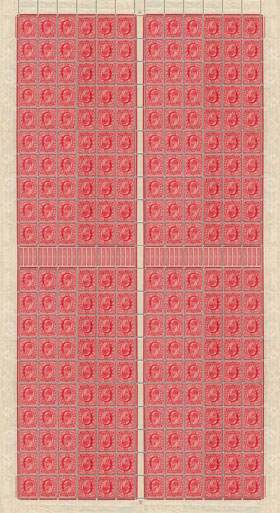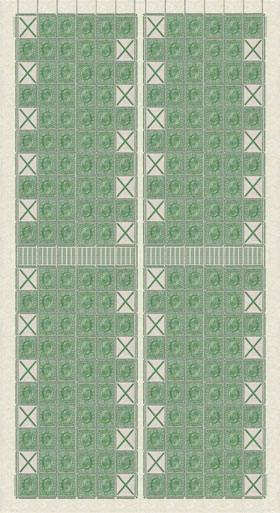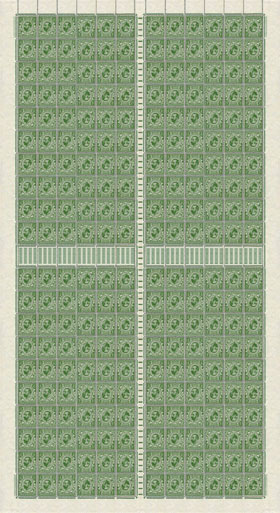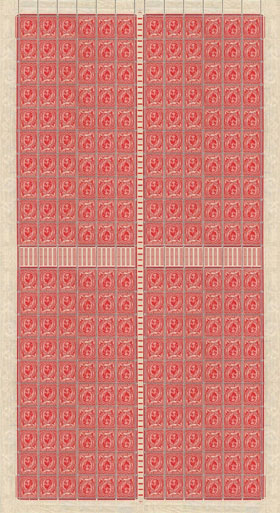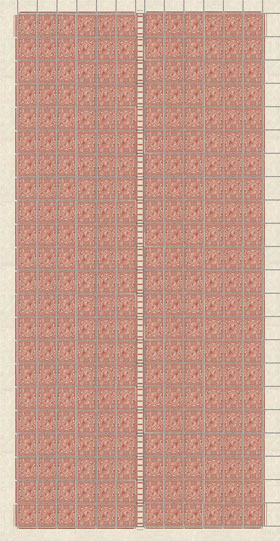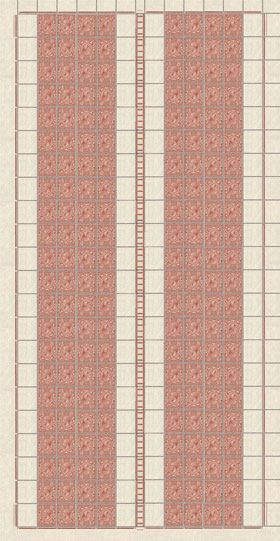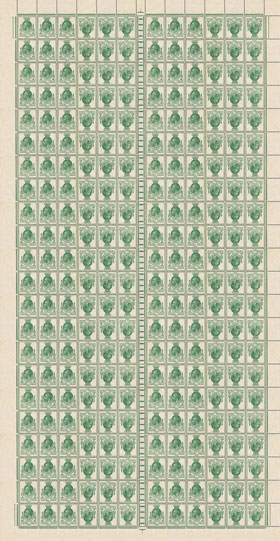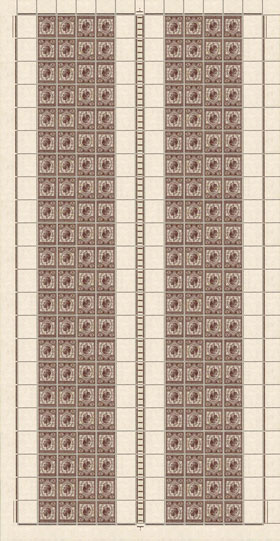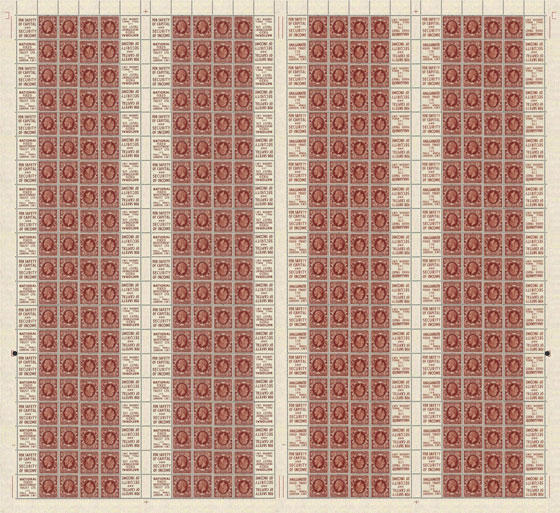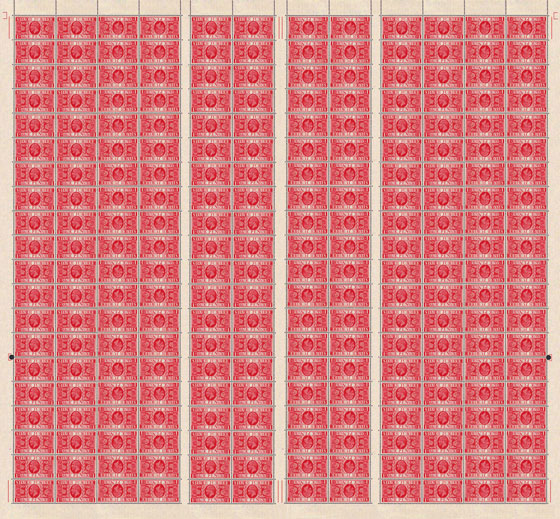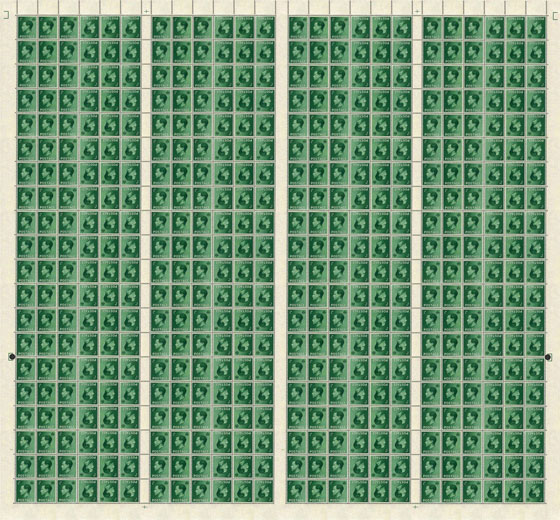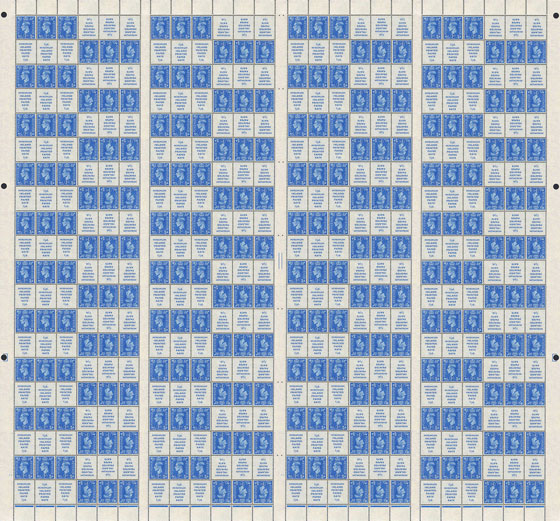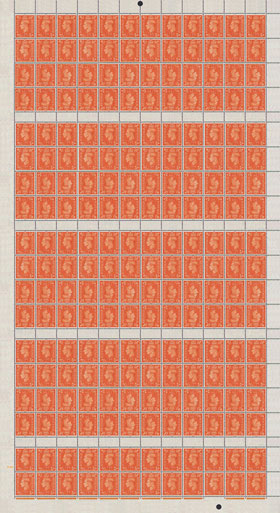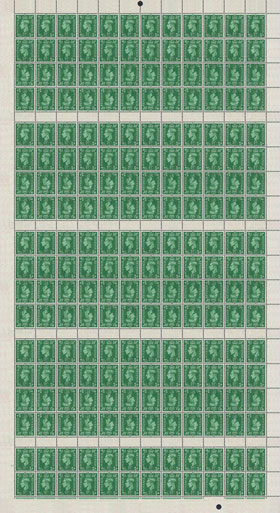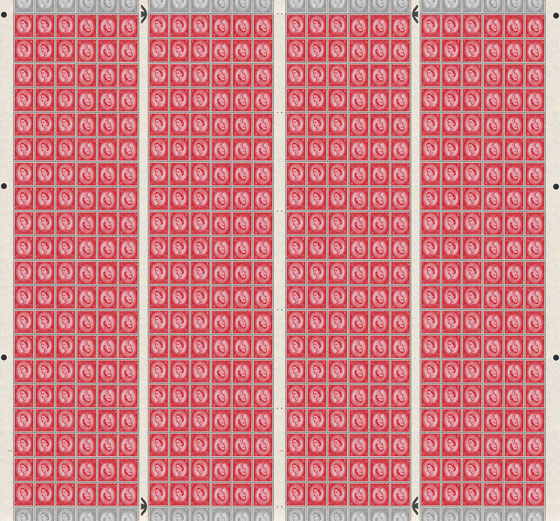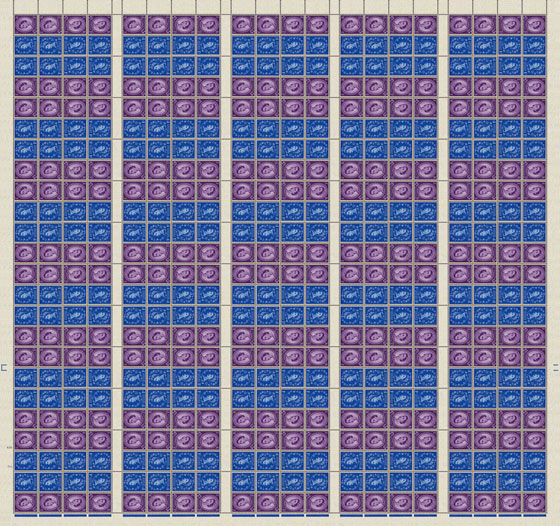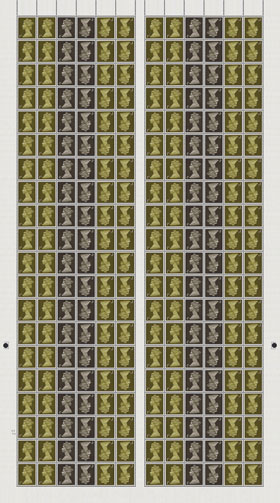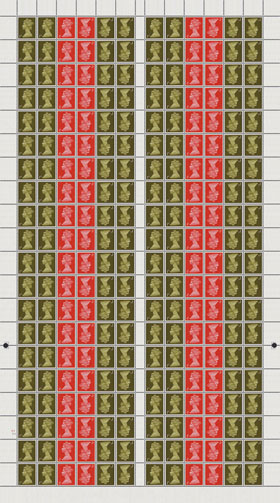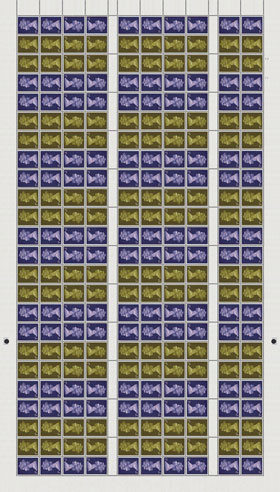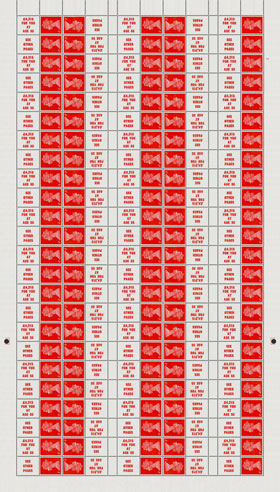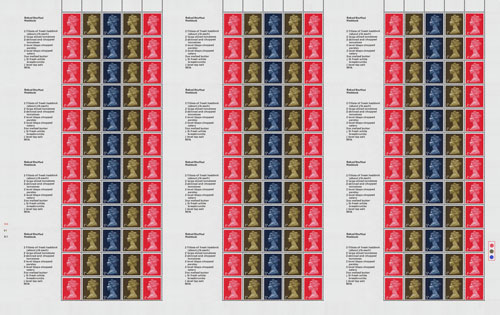
Perforation Types E, P, and I
An understanding of how booklets were made from sheets of stamps is not only an interesting subject to study, but also allows us to spot those booklets that are not quite right. Over the years some booklets have been “re-made” by re-stapling or re-stitching loose stamp panes, or panes made from blocks of stamps, into empty covers. Sometimes by overly enthusiastic collectors wanting to fill a gap, other times by individuals for profit.
Some indications are obvious, such as hinge remnants on the back of stamp panes, others not so obvious. For individual booklets, knowing the construction tells us which perforation types to expect on the panes, which watermarks and orientations, which staple and thread types, which edges were guillotined, and which interleaves to expect.
King Edward VII
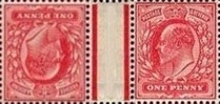
The first booklet sheets contained 240 stamps arranged as four panes of 60 stamps each, the top and bottom panes separated by a horizontal interpane gutter the same height as one stamp (0.95″), and the left and right panes separated by a vertical gutter half the width of one stamp (0.4″), which was used as the pane selvedge. The 1st and 3rd columns of panes were printed upright, the 2nd and 4th inverted, giving 20 upright booklet panes, and 20 inverted.
This layout was used by De La Rue and Harrison, and continued through King George V Downey Head and Royal Cypher issues. It was changed in 1924 when the printing contract passed to Waterlow, when the horizontal interpane gutter was removed and two extra rows of stamps added.
De La Rue used a horizontal comb perforator on booklets BA1-5 which had an extension pin at each end of the comb, but which perforated through the vertical gutter. Panes from the outer columns are perforated Type B1(E), and those from the inner columns are Type B1A(P). Using a single letter per pane, each row is: EPPE
Harrison used a different horizontal machine with an extension pin on each side of the vertical gutter, resulting in all panes perforated Type B1(E). This perforator was used on booklet BA6 and continued in use until 1919. Each row is: EEEE
| De La Rue | horizontal | EPPE | B1(E) | B1A(P) |
| Harrison | horizontal | EEEE | B1(E) | B1(E) |
In the two reconstructions below, the 1d sheet is shown as perforated by De La Rue, and the ½d sheet as perforated by Harrison.
Click the images to enlarge.
Although special plates were made to print the booklet stamps, they were printed on the same Crown Mill Sheets as counter sheet stamps. The Imperial Crown watermarks were in panes 12 wide by 10 high, hence the need for a horizontal interpane gutter to align the stamp images with the crowns. The vertical gutter caused the crowns to be offset left or right, sometimes including part of the word POSTAGE from the border of the watermark.

The layout of the booklet covers and interleaves followed that of the stamp sheets, all of which were guillotined to the same sheet size just prior to assembly. Vertical cutting guidelines can be seen next to the stamps at the four corners of the sheet.
One of each of the cover, stamp, and interleaf sheets were taken in the order required in the finished booklet, aligned, then bound twice down the center and once at each side to form a “mass” of 40 booklets. Binding was initially with staples but changed to sewn with thread during the first world war due to a shortage of staples.
The mass was separated into individual booklets by guillotine or by rotary cutter, and the horizontal interpane gutter discarded.
King George V
Downey Head
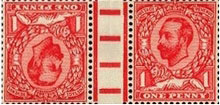
The Downey Head sheets were the same layout as the Edwardian sheets but with the addition of short horizontal bars in the vertical gutter. Perforations were also the same using the horizontal comb machine with a single extension pin that produced perforation Type B1(E). However, in the rush to issue booklets for the new reign, a small number of Crown watermark sheets were perforated using a vertical perforator normally used for counter sheets. This was achieved by dividing the sheets vertically and perforating the horizontal bars first, producing perforation Types B3(I) and B3A(P).
| Main perforator | horizontal | EEEE | B1(E) | B1(E) |
| Counter perforator | vertical | PIIP | B3A(P) | B3(I) |
Click the images to enlarge.
Profile Head
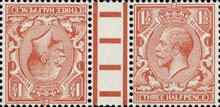
The Profile Head sheets were initially the same layout as the Downey Head sheets and were perforated using the same horizontal comb machine.
A vertical perforating machine was introduced in February 1919. Sheets could be fed left side or right side first, the first pane to enter the perforator receiving an imperforate selvedge Type B3(I), and all other panes receiving perforated selvedge Type B3A(P). This perforator remained in use until 1934, by Harrison, then Waterlow, then back to Harrison for the provisional printing, and continued as a reserve perforator for the photogravure issues.
When the printing contract changed from Harrison to Waterlow in 1924, Waterlow removed the horizontal interpane gutter and added two extra rows of stamps, giving each sheet 264 stamps arranged as 22 upright booklet panes, and 22 inverted.
| before Feb 1919 | horizontal | EEEE | B1(E) | B1(E) |
| from Feb 1919 | vertical | IPPP | B3(I) | B3A(P) |
Click the images to enlarge.
P.U.C.
The Postal Union Congress sheets were the same layout as the Waterlow profile head sheets, and were perforated using the same vertical perforating machine.
| P.U.C. | vertical | IPPP | B3(I) | B3A(P) |
Click the images to enlarge.
Photogravure
Booklet panes of six were printed in photogravure using double cylinders (no-dot and dot sheets), each sheet having 240 stamps arranged as 20 upright booklet panes, and 20 inverted.
Cylinder numbers were to the left of row 18 on both the no-dot and dot sheets, next to upright panes, thus cylinder number panes have an upright watermark. Some cylinder number panes exist with an inverted watermark, resulting from sheets which were printed inverted, but these are rare.
Perforation guidelines and punch holes were between rows 14 & 15 for sheets perforated by the horizontal machines. Guidelines were printed between every seventh row (0-1, 7-8, 14-15) in preparation for perforation in the web, although sheets of this issue were never so perforated, and the holes were not punched. The guidelines between rows 7 & 8 were usually omitted, but were incorrectly positioned on both sides of 1d cylinder F7, resulting in panes with lines visible in the middle of the selvage. Small crosses were at the top and bottom of the inter-pane gutters for the vertical machine.
Two new horizontal perforating machines were introduced for the photogravure sheets, although the vertical machine from 1919 was occasionally used as a reserve. The horizontal machines perforated the full width of the double sheet from bottom to top. For the vertical machine the double sheet was divided, the no-dot sheet perforated from left to right, and the dot sheet from right to left.
| Main perforator | horizontal | EPPI-IPPE | B4(E) no-dot | B4A(I) dot |
| Reserve perforator | horizontal | EPPE-EPPE | B4(E) no-dot | B4B(E) dot |
| Second reserve | vertical | IPPP-PPPI | B3(I) no-dot | B3A(P) dot |
Click the image to enlarge.
Silver Jubilee
Booklet panes of four were printed in photogravure using double cylinders (no-dot and dot sheets), the no-dot sheet having 120 stamps arranged as 20 upright booklet panes and 10 inverted, the dot sheet having 10 upright and 20 inverted.
Cylinder numbers were to the left of row 18 on both the no-dot and dot sheets, but only the no-dot margin became part of the finished booklets, the dot cylinder number was discarded. Vertical cutting guidelines were at the four corners of the sheet, with additional lines in the central vertical gutter on the 1d cylinder, presumably in error as these would not have been used.
Perforation guidelines and punch holes were between rows 14 & 15 for sheets perforated by the horizontal machines. Guidelines were printed between every seventh row (0-1, 7-8, 14-15) in preparation for perforation in the web, although sheets of this issue were never so perforated, and the holes were not punched. The guidelines between rows 7 & 8 were usually omitted. Some 1½d panes show guidelines without a punch hole, probably from incorrectly positioned lines on one of the 1½d cylinders, thought to be between rows 6 & 7.
Sheets were perforated using a horizontal machine, adapted for the Silver Jubilee issue. These perforation types were once called B2(E).
| Silver Jubilee | horizontal | EEE-EEE | B4(E) no-dot | B4(E) dot |
Click the image to enlarge.
King Edward VIII
Booklet panes of six were printed in photogravure using double cylinders (no-dot and dot sheets), each sheet having 240 stamps arranged as 20 upright booklet panes, and 20 inverted.
Cylinder numbers were to the left of row 18 on both the no-dot and dot sheets, next to upright panes, thus cylinder number panes have an upright watermark. Cylinder number booklets may contain a mixture of upright panes with cylinder numbers, and inverted panes without cylinder numbers.
Perforation guidelines and punch holes were between rows 14 & 15 for sheets perforated by the horizontal machines. Guidelines were printed between every seventh row (0-1, 7-8, 14-15) in preparation for perforation in the web, although sheets of this issue were never so perforated, and the holes were not punched. The guidelines between rows 7 & 8 were usually omitted. The lines between rows 0 & 1 were incorrectly positioned on both sides of ½d cylinder E2, resulting in panes with lines visible in the selvage. Small crosses were at the top and bottom of the inter-pane gutters for the vertical machine.
Booklet panes of two were made from sheets of PB5 advert panes before the adverts were printed, with the unprinted labels trimmed to form a binding margin.
Sheets were perforated using the same three machines as for King George V photogravure booklets, being the two horizontal machines introduced for photogravure (although the second was out of service for much of the reign), and the vertical machine from 1919. The latter was not used on advert panes, so advert cylinder panes are never perforated through.
| Main perforator | horizontal | EPPI-IPPE | B4(E) no-dot | B4A(I) dot |
| Reserve perforator | horizontal | EPPE-EPPE | B4(E) no-dot | B4B(E) dot |
| Second reserve | vertical | IPPP-PPPI | B3(I) no-dot | B3A(P) dot |
Click the image to enlarge.
King George VI
Booklet panes of six were printed in photogravure using double cylinders (no-dot and dot sheets), and some from Oct 1938 to Jan 1943 using single sheet cylinders (no-dot only), each sheet having 240 stamps arranged as 20 upright booklet panes, and 20 inverted.
Cylinder numbers were to the left of row 18 on both the no-dot and dot sheets, except for the 1d/label se-tenant sheets, on which they were to the left of row 19. Perforation guides were between rows 14 & 15 for sheets perforated by the horizontal machines, and every seventh row (0-1, 7-8, 14-15) on sheets perforated in the web.
Booklet panes of four were made from sheets intended for coils (BD3), from the top and bottom rows of counter sheets (BD6, BD7), and from sheets of 216 designed for “E” stamp booklets (BD8, BD9, BD10). Sheets were separated into blocks of stamps 12 wide by two high, enough to make a strip of six booklets. The strips were stacked with covers, sewn and then cut into individual booklets.
Booklet panes of two were made from sheets of QB23 advert panes (BD1), from sheets of panes of six (BD2), and from the first two columns of counter sheets (BD4, BD5). Sheets were separated into blocks of stamps two wide by 10 high with a binding margin on the left, enough to make a strip of 10 booklets. The strips were stacked with covers, sewn and then cut into individual booklets.
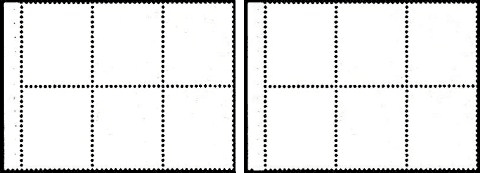
Perforation Types BP and Ie
Sheets intended for panes of six were initially perforated using the same machines as the previous reign, the vertical machine producing B3(I) and B3A(P), and the horizontal machines giving B4(E), B4A(I) and B4B(E).
| Main perforator | horizontal | EPPI-IPPE | B4(E) no-dot | B4A(I) dot |
| Reserve perforator | horizontal | EPPE-EPPE | B4(E) no-dot | B4B(E) dot |
| Second reserve | vertical | IPPP-PPPI | B3(I) no-dot | B3A(P) dot |
| Single sheet cyls | vertical | IPPP | B3(I) no-dot | — |
A triple comb machine was introduced in 1943, during the Pale Colours, which perforated in the web. This produced B3(I) and B5(BP). After some months, two selvedge pins were removed changing the perforations to B3(I) and B6(Ie). This was in use until 1955.
| Pins in place | in the web | III BP-BP III | B3(I) no-dot | B5(BP) dot |
| Pins removed | in the web | III Ie-Ie III | B3(I) no-dot | B6(Ie) dot |
Se-tenant label sheet — click the image to enlarge.
Sheets of 216 designed for “E” stamp booklets were perforated through all selvedges that would form part of the finished booklets. The left and right margins, including the cylinder number, were discarded. Jubilee lines at the bottom of the sheet, under all stamps except stamp 10, were also discarded.
“E” sheets — click the images to enlarge.
Queen Elizabeth II
Wilding Booklets
Booklet panes of six were printed in photogravure using double cylinders (no-dot and dot sheets), each sheet having 240 stamps arranged as 20 upright booklet panes, and 20 inverted.
Cylinders with 21 rows were introduced in 1957. The continuously printed reel was guillotined into sheets of 20 rows before assembly into booklets, resulting in the cylinder number advancing one row on each successive sheet. Cylinder numbers may be found next to the top or bottom row of the pane in finished booklets from these cylinders. Perforation guides were every seventh row.
Booklet panes of four were made from sheets of 216 designed for “E” stamp booklets (K1-3, N1-3), from sheets of 240 (NR1/a) which were similar to “E” sheets but with an additional row of six panes of four, and from sheets of 480 with watermark Crowns sideways.
Booklet panes of two were made from the first two columns of counter sheets (E1, E2).
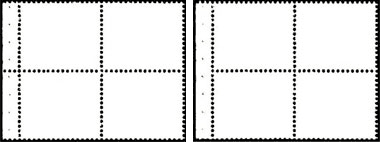
Perforation Types P and AP
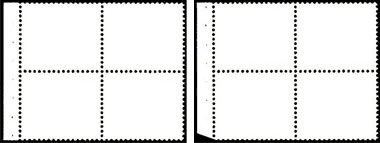
Perforation Types I and I(½v)
Sheets intended for panes of six were initially perforated using the three-row comb machine introduced in 1943 which perforated in the web. This produced B3(I) and B6(Ie). A four-row comb was used after the change to 21-row cylinders, also producing B3(I) and B6(Ie). Thus, all Wilding panes of six have perforation Type I or Ie.
Crowns sideways sheets were perforated using a two-row comb machine producing Type I in the sheet side margins, and Type AP (alternate perforate) across the four vertical gutters. These sheets, and those from experimental booklet NR1/a, were torn in half along the central row of perforations before assembly into the mass of 60 booklets (30 for NR1/a).
Booklet panes from booklet NR1/a, and panes with watermark Crowns sideways, exist with a half-V cut in the selvedge at top or bottom, Type I(½v). This cut aided removal of the imperforate margin, which was torn off by hand.
| Panes of six | in the web | III Ie-Ie III | I | Ie |
| Crowns sideways | horizontal | IAAAA-AAAAI | I | AP |
21-row sheet — click the image to enlarge.
Crowns sideways sheet — click the image to enlarge.
Machin Booklets
Booklet panes of six were printed in photogravure using double cylinders (no-dot and dot sheets), and some using single sheet cylinders (no-dot only), each sheet having 240 stamps arranged as 20 upright booklet panes, and 20 inverted.
Booklet panes of six, other than the 1d/4d se-tenant panes, were printed from 21-row cylinders and perforated in the web using the four-row comb machine introduced in 1957, Type I or Ie. The continuously printed reel was guillotined into sheets of 20 rows before assembly into booklets, resulting in the cylinder number advancing one row on each successive sheet. Cylinder numbers may be found next to the top or bottom row of the pane in finished booklets from these cylinders.
The 1d/4d se-tenant panes of six were printed on a Halley press and perforated as 20-row sheets. Cylinder numbers were to the left of row 18 with both cylinder numbers (N5/F4) found next to the bottom row of the pane in finished booklets. These sheets were initially perforated Type I then changed to Type P part way through the Sept 1968 print run.
Perfs I & P — click the images to enlarge.
Booklet panes of four were printed on a Halley press as sheets of 240 (half the width of the Crowns sideways sheets). These sheets were perforated Type I in the side margins, and Type AP (alternate perforate) or Type P across the two vertical gutters.
Perfs AP & P — click the images to enlarge.
Stamps for Cooks
Booklet panes of 15 were printed in photogravure using single sheet cylinders, each sheet having 180 stamps arranged as 12 upright booklet panes.
Sheets were perforated, stacked with covers and interleaves, then guillotined vertically into strips of four booklets. The strips were stapled or sewn at the left, then cut into individual booklets.
Click the image to enlarge.
